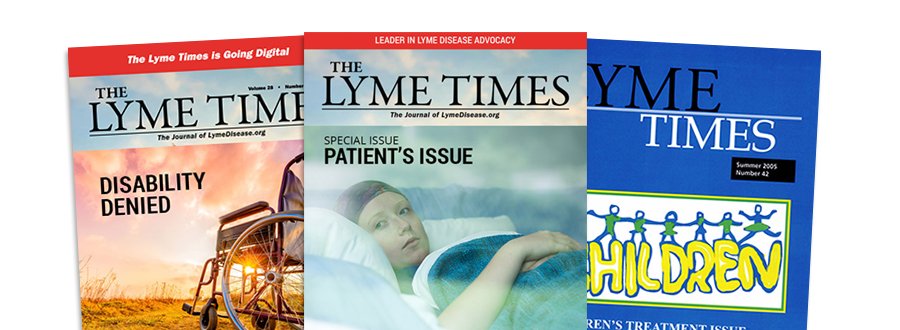- Home
- Find A Physician
- FIND A PHYSICIAN
- LymeTimes
- Current Issue
- Archives
- FEATURED LYMEDISEASE.ORG ISSUES
- Resources
- LYME LITERATE PHYSICIAN VIDEOS
- Physicians
- Members
- About Us
- Resources
 V enturing out in nature can introduce us to a silent adversary: ticks. When I finally realized that my husband’s early-onset Alzheimer’s was caused by Lyme disease and other co-infections, I tried to use my engineering background to make sense of it all.
V enturing out in nature can introduce us to a silent adversary: ticks. When I finally realized that my husband’s early-onset Alzheimer’s was caused by Lyme disease and other co-infections, I tried to use my engineering background to make sense of it all.
I very quickly found myself lost. An excerpt from my memoir about our experience shows how confused I was as a newly minted caregiver.
January 2018 – Lost in the literature
(Excerpt from What Lurks in the Woods: Struggle and Hope in the Midst of Chronic Illness)
I poured every spare moment into research. Of course, I started where everyone starts: the Internet. I quickly realized what I already knew. The Internet was a dangerous place to get information. My searches left me more confused than when I started.
Half of the articles insisted that chronic Lyme didn’t exist. The Centers for Disease Control and Prevention, the CDC, claimed Lyme could be treated with two to four weeks of antibiotics. After that, anyone still sick didn’t have chronic Lyme; they had Post-Treatment Lyme Disease Syndrome or PTLDS. But the causes of PTLDS were unknown. It could be an autoimmune response triggered by the bacteria. It could be a persistent but difficult to detect infection. It could be other issues unrelated to Lyme. As I read their position over and over again, it didn’t make sense. One of their explanations for PTLDS was a “persistent but difficult to detect infection.” Um, okay. Why couldn’t that be Lyme?
The other half of the articles blamed Lyme for nearly every chronic disease on the planet: fibromyalgia, arthritis, chronic fatigue syndrome, multiple sclerosis, myocarditis, Parkinson’s, Alzheimer’s, scleroderma, depression, schizophrenia. The bacteria was invading our immune system and wreaking havoc. It infected joints, brain tissue, and cardiac tissue. It triggered autoimmune conditions, dementia, and mental illness. The disease was way under-reported and globally prevalent, not only in the American Northeast.
So, what to believe? Frustrated, I turned away from Internet articles and turned toward scientific articles on PubMed. The messages there were equally mixed. I scanned through titles and abstracts. For each article I found supporting chronic Lyme’s existence, I found another attempting to debunk it. Clearly, I needed to read the articles to form my opinion, so I dug in. I found observational studies with no controls, failed attempts to reproduce past results, citations to other papers that didn’t say what was claimed. The more I read, the more frustrated I became.
I had long been a steward of science. “In God we trust; all others must bring data.” The quote from W. Edwards Deming was frequently touted at the FDA and always made me smile. I agreed. Data was pure. Data had no agenda. Data was just data.……….Join or login below to continue reading.
You must be a LymeDisease.org member to access this content.





























